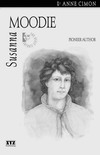Susanna Moodie, pioneer author, Anne Cimon, XYZ Publishing, 2006.
Of the many immigrant groups that streamed into Canada, none is so curious and interesting, as the Victorian gentry emigrating here. Susanna Moodie arrived in 1832. Educated, impecunious, idealistic, her story reveals much about the misconceptions these 19th century people had of the New World.
Susanna (née Strickland), at 29, recently married to John Moodie, an ex-army captain, along with their first child, Katie, all arrive at Coburg, Ontario, to claim his officer’s land allotment. Thus begins the couple’s saga at eking a living from a wilderness farm. In her genteel yet modest Suffolk youth, Susanna had published poetry and she thought she would host literary teas in her adopted country.
The reality proves very different. Susanna struggles against adversity, thriving for a time, but virtually homeless at age 82, at the end of a remarkable life that encompassed a wealth of experience few ever achieve. During her ‘bush years’, as she refers to the wilderness, she and her family rely on presents sent from England to save them from perdition. Luck sometimes blesses her. Her sister, Catherine Parr Traill, settles nearby. Susanna talks about the cleaving of one’s soul in leaving one’s homeland.
Anne Cimon, a Montreal author with several acclaimed collections of prose and poetry, spent five years researching and writing her biography. Cimon felt drawn to Susanna’s resolve, and her belief in a ‘psychic link between people’. Cimon credits her spiritual presence as providing her with solace during her own life crisis. With a fluid, intimate style, Cimon gathers the length and breadth of Susanna’s reversals and occasional good fortune as a pioneer author defining the quintessential Canadian settler experience.
She bears four children during the seven years that she and John farmed the land. Captain Moodie resumes his service during the 1837-38 Rebellions, and Susanna is left alone to battle poverty and isolation. Despite this, she writes ceaselessly by candlelight, nurturing her hopes and dreams of establishing a better life for her and her family, struggling for a life of the mind, a quest that is difficult as the forbidding ground.
She is visited by hardship, disaster, sickness, rejection and personal tragedy that would fill volumes. Cimon distils her narrative with a raconteur’s blend of interesting and significant detail. In 1852, Susanna publishes ‘Roughing It In The Bush’, a best seller on both sides of the Atlantic. However, inadequate copyright protection translates into scant improvement in her financial circumstances.
Eventually, by pluck and sheer determination, she and John prosper, moving to a stone house in Belleville. Rebellion turmoil and partisanship embroil their lives, the more so as John is sheriff. The Moodies befriend Robert Baldwin, also a Belleville resident. An accomplished poet, the Reform prime minister admires Susanna’s writing. The Moodies name a son after him.
Susanna’s arduous efforts (using her new china tea service) at creating an intellectual circle are spurned by the self-righteous, ignorant ladies in her community. Her dashed hopes are echoed in Lord Durham’s 1839 Report, which scathingly decries English provincial philistinism.
Aided by literary allies like Montreal publisher, John Lovell, Susanna carves out a niche for herself. Travelling, her poetic freshness opens onto the disappearing wilderness. A trip to Niagara inspires: ‘The Falls…flow down upon your vision like moving mountains of light.’ Her peregrinations include a visit to the Toronto Lunatic Asylum, and Kingston Penitentiary where she meets infamous murderess Grace Marks.
Her love relationship with John is strengthened by their travails. But their trusting natures spawn trouble. Dunbar, their son, besotted with an adventuress, bilks them of their home and savings. Lifelong scrounging has Susanna trying her hand at virtually anything. She reveals herself as an accomplished painter of nature studies that augment her income. Susanna’s creativity is evident amongst her brother and sisters, all published writers (more venturesome Brontës?). Even John publishes a book on his South African sojourn.
The publishers include an appendix with a handy historical timeline but unfortunately don’t include a footnote about the seminal Reform movement that so shaped the times.
This delightful, well-written, biography of an intrepid and thoughtful woman, set in the era of burgeoning rail travel, would make a thoughtful gift for any young adult. Both giver and recipient will end up discussing this treasure.
